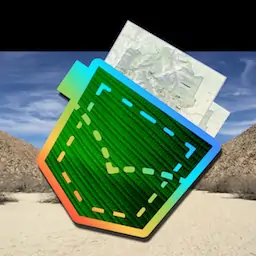"Winter Panoramic" by National Park Service , public domain
GeologyCrater Lake |
Geology brochure for Crater Lake National Park (NP) in Oregon. Published by the National Park Service (NPS).
featured in
| National Parks Pocket Maps |  | |
| Oregon Pocket Maps |  |
Crater Lake
National Park Service
U.S. Department of the Interior
Crater Lake National Park
Painting by Paul C. Rockwood
Geology
Crater Lake National
Park remains part of a
restless landscape
The calm beauty of Crater Lake obscures the violent forces that formed it. Crater Lake
lies inside the collapsed remnants of an ancient volcano known as Mount Mazama. Its
greatest eruption, about 7,700 years ago, was the largest to occur in North America for
more than half a million years. Though the mountain has now been dormant for five
thousand years, geologists do expect it to reawaken someday.
Formation of the
Cascade Range
Mount Mazama is part of a chain of volcanoes that
extends along the crest of the Cascade Range from
Lassen Peak in California to Mount Garibaldi in
British Columbia. Two other peaks (Mount Rainier
and Lassen) are also part of national parks.
These volcanoes are the visible evidence of what
geologists call “plate tectonics.” The earth's surface,
seemingly solid, is actually broken up into many
huge plates, all floating on top of the Earth's molten
interior. As these plates slowly drift, the continents
and adjacent sea floor either move apart or push
into one another. Continental crust is thicker than
oceanic crust and tends to be less yielding.
A Cataclysmic Eruption
Mount Mazama began to grow half a million years
ago. The oldest rocks visible today, 420,000 years
old, form Mount Scott on the east side of Crater
Lake. Over time, lava flowed from many volcanic
vents, overlapping and building an irregularlyshaped mountain. By 8,000 years ago, Mount
Mazama may have stood as much as 12,000 feet
(3,660 meters) tall.
Mount Mazama’s most violent eruption occurred
about 7,700 years ago. A column of hot gas and
volcanic rock was ejected high into the air. This
magma fell to the earth as fragments of frothy white
When a plate carrying oceanic crust pushed into
what is now the northwestern United States, it was
forced under the less-yielding continental plate.
Tremendous pressures were exerted on the oceanic plate, causing it to deform and even melt. This
melted rock is called magma. It is lighter and more
fluid than the surrounding rock and tends to rise.
Volcanic eruptions eventually bring the magma
back onto the surface of the earth where it is then
called lava. This process, over a period of millions
of years, formed the Cascade Range. The High
Cascade volcanoes we see today, including Mount
Mazama, are the most recent results of this process.
pumice and volcanic ash. Layers of ash from this
eruption may still be found in the soil as far away as
Alberta, Canada, more than 1,000 miles away.
Explosions on the northeast side of the mountain
produced fast-moving flows of hot ash. In all, 12
cubic miles (50 cubic kilometers) of material
poured out of the volcano, draining the magma
chamber beneath it. As the underlying support for
the mountain was lost, the walls of the volcano
began to collapse inward. The top of a mountain
that was built over hundreds of thousands of years
probably “disappeared” in a few days.
Sequence of events. Mount Mazama grew for almost half a million years. 7,700 years ago, it erupted violently, then collapsed into itself. Since
then, rain and snow have filled Crater Lake, and other eruptions have created features including Wizard Island.
Recent Activity
What Will Happen Next?
After the collapse of Mount Mazama, minor eruptions continued inside the newly formed caldera (a
word that comes from the Spanish word for
“kettle” or “boiler” and is used by geologists to
describe large basin-shaped volcanic depressions).
These recent flows created Wizard Island, which
projects 764 feet (233 meters) above the lake’s
surface, and Merriam Cone, which is submerged.
About 5,000 years ago, a small eruption formed a
lava dome, just east of Wizard Island, which is also
under the surface of the water.
"Crater Lake partially fills a 1,200-meter [4,000foot] deep caldera, a depression formed by collapse
of ancestral Mount Mazama during the violent
eruption of 50 cubic kilometers of magma, or
molten rock, about 7,700 years ago... By comparison, Mount St. Helens in 1980 erupted about half a
cubic kilometer of new magma. Geological history
shows that catastrophic events of this kind can
repeat. Are volcanic eruptions likely again at Crater
Lake? One of the approaches U.S. Geological
Survey scientists are using to answer this important
question is to unravel the geologic history of the
Crater Lake caldera floor."
On the other hand, there is every reason to expect
some kind of future volcanic activity in the place
where it has been occurring for almost half a million years. Should there be an eruption within the
caldera, it would likely happen underwater, increasing the possibility of enhanced explosive power due
to the interaction of magma and hot rock with
water.
- Dr. Hans Nelson and Dr. Charles R. Bacon,
U.S. Geological Survey
The foremost threat from young calderas is that of
renewed volcanic activity. Another eruption as big
as the caldera-forming event, however, is unlikely.
No volcanic activity has occurred at Mount
Mazama in the last 5,000 years; studies of lake
sediments show no evidence of magma movement
beneath the earth’s surface; and there have been no
earthquakes of the kind associated with volcanic
activity.
For More Information
about Volcanoes...
Over the course of several hundred years following
the creation of the caldera, rain and snow filled the
basin to a depth of 1,943 feet (592 meters). Crater
Lake today is the nation’s deepest lake.
Calderas filled with water can also produce tremendous flooding if the caldera wall fails. However,
Crater Lake shows no signs of imminent crater-wall
failure: the last major wall failure occurred more
than 7,500 years ago, soon after the cataclysmic
eruption of Mt. Mazama.
Scientists from the U.S. Geological Survey, the
National Park Service, local universities, and other
agencies continue to study Crater Lake and its
geology. In addition, scientists from the USGS
Cascade Volcano Observatory periodically make
geodetic measurements and look for tilting or
swelling of the caldera area that might forewarn of
renewed volcanic activity.
Crater Lake National Park
http://www.nps.gov/crla/home.htm
Global Volcanism Program
http://www.volcano.si.edu/gvp/
Cascade Volcanoes Observatory
http://vulcan.wr.usgs.gov/
Volcano World
http://volcano.und.nodak.edu/
EXPERIENCE YOUR AMERICA
R e v. 12/2001 klb


